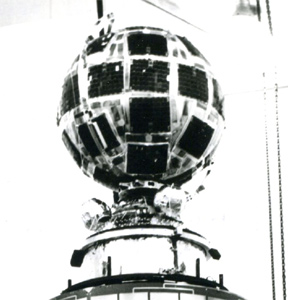Dual Air Density Explorer
 Explorer (56) (DADE-A) satellite | |
| Names | DADE-A Dual Air Density Explorer-A |
|---|---|
| Mission type | Earth science |
| Operator | NASA |
| COSPAR ID | 1975-DADE-A |
| Mission duration | Failed to orbit |
| Spacecraft properties | |
| Spacecraft | Explorer LVI |
| Spacecraft type | Dual Air Density Explorer |
| Bus | DADE |
| Manufacturer | Langley Research Center |
| Launch mass | 40 kg (88 lb) |
| Power | Solar cellsandbatteries |
| Start of mission | |
| Launch date | 6 December 1975, 03:35:01UTC[1] |
| Rocket | Scout F-1(S-196C) |
| Launch site | Vandenberg,SLC-5 |
| Contractor | Vought |
| End of mission | |
| Deactivated | Failed to orbit |
| Orbital parameters | |
| Reference system | Geocentric orbit(planned) |
| Regime | Polar orbit |
| Perigee altitude | 350 km (220 mi) |
| Apogee altitude | 350 km (220 mi) |
| Inclination | 90.10° |
| Period | 90.00 minutes |
| Instruments | |
| Atmospheric Composition Mass Spectrometer Atmospheric Drag Density | |
Explorer program | |
Dual Air Density Explorerwas a set of 2 satellites,DADE-AandDADE-B,released as part ofNASA'sExplorer program.DADE-A and DADE-B was launched on 6 December 1975 at 03:35:01UTC,[1]by aScout F-1launch vehiclefromSpace Launch Complex 5,Vandenberg Air Force Base,California.The launch of the DADE satellites failed.[2][3]
Spacecraft[edit]
The Dual Air Density Explorer-A (DADE-A) satellite was a 76 cm (30 in) rigid sphere designed to determine, in conjunction with Dual Air Density Explorer-B (DADE-B), the vertical structure of the upper thermosphereand thelower exosphereas a function oflatitude,season,andlocal solar time.Both satellites would have been launched by a single Scout launch vehicle into coplanar polar orbits. Measurements ofatmospheric densityfrom DADE-A would have been obtained from satellite drag analyses nearperigee(approximately 350 km (220 mi)) and from composition measurements taken by an onboardmass spectrometer.DADE-A was equipped with aradio beaconto facilitate tracking.[2]
Experiments[edit]
Atmospheric Composition Mass Spectrometer[edit]
The mass spectrometer experiment on DADE-A was designed to perform composition measurements in the upper thermosphere (approximately 350 km (220 mi)). The instrument was a magnetic massspectrometerwith a Mattauch-Herzog geometry and would have measured the distribution of such atmospheric constituents asoxygen,nitrogen,helium,hydrogen,neonandargon.[4]
Atmospheric Drag Density[edit]
The atmospheric drag density experiment on DADE-A was designed to provide indirect measurements of upper thermospheric density near satellite perigee (approximately 350 km (220 mi)). The experiment had no unique onboard hardware. The density values would have been derived from sequential observations of the satellite's position. The experiment would have yielded systematic values of atmospheric density as a function of latitude, season, and local solar time.[5]
See also[edit]
References[edit]
- ^ab"Launch Log".Jonathan's Space Report. 21 July 2021.Retrieved19 November2021.
- ^ab"Display: DADE-A".NASA. 28 October 2021.Retrieved19 November2021.
 This article incorporates text from this source, which is in thepublic domain.
This article incorporates text from this source, which is in thepublic domain.
- ^"Display: DADE-B".NASA. 28 October 2021.Retrieved19 November2021.
 This article incorporates text from this source, which is in thepublic domain.
This article incorporates text from this source, which is in thepublic domain.
- ^"Experiment: Atmospheric Composition Mass Spectrometer".NASA. 28 October 2021.Retrieved19 November2021.
 This article incorporates text from this source, which is in thepublic domain.
This article incorporates text from this source, which is in thepublic domain.
- ^"Experiment: Atmospheric Drag Density".NASA. 28 October 2021.Retrieved19 November2021.
 This article incorporates text from this source, which is in thepublic domain.
This article incorporates text from this source, which is in thepublic domain.

